WHAT IS GOING ON IN MY INTESTINES?
A Closer Look at the Small Intestine, What Is the Small Intestine's Main Job?
Humans have two types of intestines. One is the small intestine, and one is the large intestine. Each has a different job. But both are important. They make up the final steps of digestion.
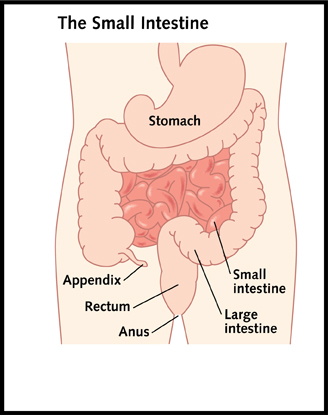 The small intestine lies beneath the stomach. Food from the stomach comes here.
The small intestine lies beneath the stomach. Food from the stomach comes here.
A Closer Look at the Small Intestine
After food is broken up in the stomach, it moves into the small intestine. By this time, it has been broken down into small chemicals. The small intestine can handle small chemicals more easily than large chemicals.
The small intestine is a long, narrow tube. It is about 2 inches (5 cm) wide. It is curled around and around beneath your stomach. If you stretched out an adult's small intestine, it would be about 23 feet (6.7 m) long.
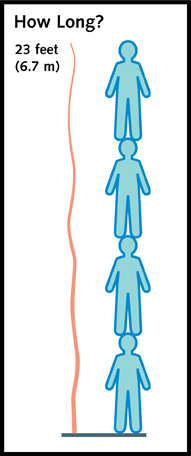 The small intestine is about 23 feet (6.7 m) long. That's about the height of four men standing on top of each other.
The small intestine is about 23 feet (6.7 m) long. That's about the height of four men standing on top of each other.
What Is the Small Intestine's Main Job?
The small intestine breaks down food even more. By the end of the small intestine, the food is broken into tiny chemicals. These can be absorbed (soaked up) into the blood.
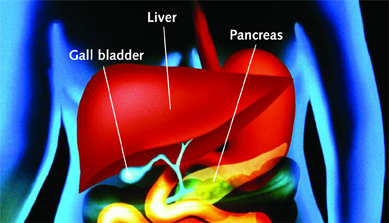 AIDING DIGESTION. The liver, gall bladder, and pancreas are three vital organs. They aid digestion in the small intestine. The liver has many important functions (see also page 31). One of the important things it does is to make a liquid called bile.
AIDING DIGESTION. The liver, gall bladder, and pancreas are three vital organs. They aid digestion in the small intestine. The liver has many important functions (see also page 31). One of the important things it does is to make a liquid called bile.
More Juices!
For the small intestine to work well, it needs more juices. Three organs produce juices that help digestion. They send the juices into the small intestine. These organs are:
- The liver
- The gall bladder
- The pancreas
What do they do?
- The liver makes a liquid called bile.
- The gall bladder stores bile until it is needed. Bile helps your body absorb fat into the bloodstream.
- The pancreas makes juices that help the body digest fats and protein.
The Problem with Fat
Fat is hard for your body to break down. Have you ever tried cleaning a greasy pan? If you have, you know it is hard to get the fat off. When you add detergent, the fat breaks into smaller pieces. Then it is easier to wash away. Bile works in a similar way. It is held in the gall bladder until you eat a fatty meal. Then it is released into the small intestine. It breaks down fat.
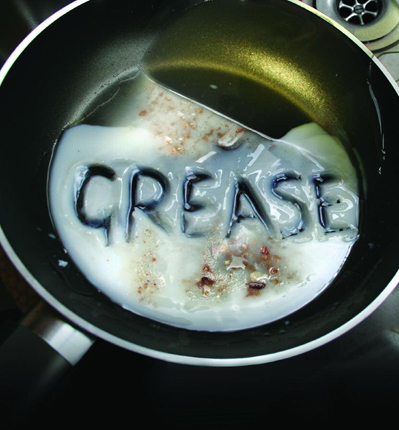 Fats such as butter and animal fats need breaking down. This happens in the small intestine.
Fats such as butter and animal fats need breaking down. This happens in the small intestine.
How Are Nutrients Absorbed?
Soon your food reaches the end of the small intestine. Then, it is ready to be absorbed. The inside of the small intestine is covered with millions of tiny “fingers.” These fingers are called villi. The villi make the surface area of the small intestine a lot bigger. If the small intestine had smooth walls, it could not absorb as many nutrients. A big surface area means more food can be absorbed. Food crosses the villi. It enters the bloodstream.
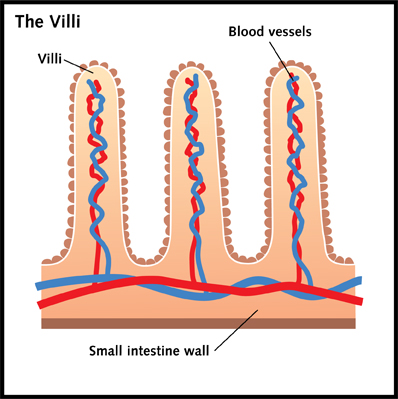 The finger shapes of the villi help the small intestine to absorb food nutrients more quickly. Villi increase the surface area.
The finger shapes of the villi help the small intestine to absorb food nutrients more quickly. Villi increase the surface area.
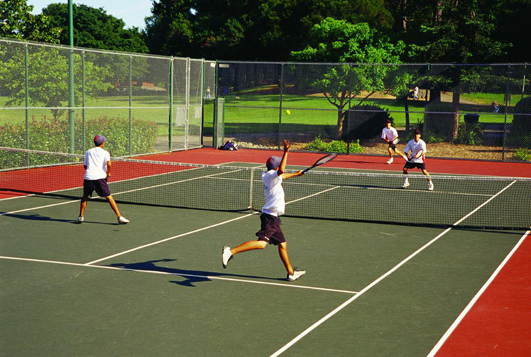 AMAZING INSIDES. Imagine the villi could be laid out flat. They would cover an area of 240 square yards (200 sq m). That's about the size of a tennis court!
AMAZING INSIDES. Imagine the villi could be laid out flat. They would cover an area of 240 square yards (200 sq m). That's about the size of a tennis court!
Where Does the Food Go Next?
The blood is rich in nutrients from food. It goes straight to the liver. The liver takes harmful matters out of the blood. For example, if someone has drunk alcohol, the liver removes the alcohol.
The liver stores some nutrients. It will release these later when they are needed. It sends other nutrients to different parts of the body.
A Closer Look at the Large Intestine
The large intestine gets rid of waste food. Not all of your food is absorbed. The body does not need some of it. This is the waste. It leaves the small intestine and moves into the large intestine. The large intestine is wider than the small intestine. It is 3–4 inches (7–10 cm) wide and 5 feet (1.5 m) long.
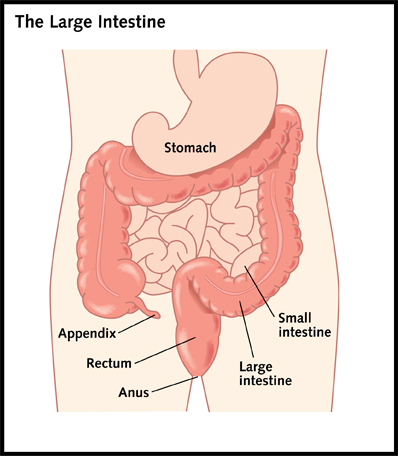 The large intestine is not as long as the small intestine. It is much wider, however.
The large intestine is not as long as the small intestine. It is much wider, however.
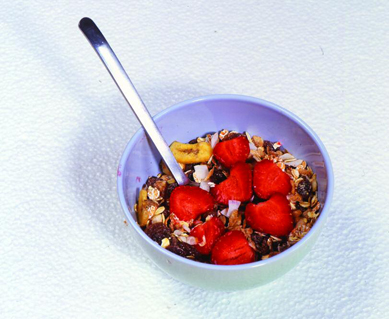 TIME TO GO. It is important to eat a diet rich in fiber. Fiber is found in plants. It adds bulk to your feces, or waste matter. Eating fiber helps you get rid of waste regularly. By eating fiber, you keep your large intestine healthy.
TIME TO GO. It is important to eat a diet rich in fiber. Fiber is found in plants. It adds bulk to your feces, or waste matter. Eating fiber helps you get rid of waste regularly. By eating fiber, you keep your large intestine healthy.
What Happens in the Large Intestine?
At the start of the large intestine, the food is runny. Water is absorbed back into the body as it moves along. This happens in a part of the large intestine called the colon. The food waste, or feces, becomes harder. They become solid as they move through the large intestine.
Eventually, they reach a storage area. This is the rectum. From there, the feces leave the body through the anus.
Additional topics
- WHY DO I NEED FOOD? - How Much Food Do I Need?, What Is a Balanced Diet?
- WHY DO I HAVE A STOMACH? - How Big Is My Stomach?, What Does the Stomach Do?, Are There Enzymes in the Stomach?
- Other Free Encyclopedias
Science Encyclopedia for KidsWhat Happens To Your Food When You Eat?